Immigration in United States - Impact, Reasons, Attempts to Stop and Economy
VerifiedAdded on 2022/11/07
|9
|2100
|75
AI Summary
This study is based on different aspects of migration in the US. The study also analyses different mass immigration timeline to identify the drivers to the immigration. The study incorporates some of the critical aspect of this context such as the level of acceptance among the natives and impact of immigration in contemporary scenario as well as economy.
Contribute Materials
Your contribution can guide someone’s learning journey. Share your
documents today.
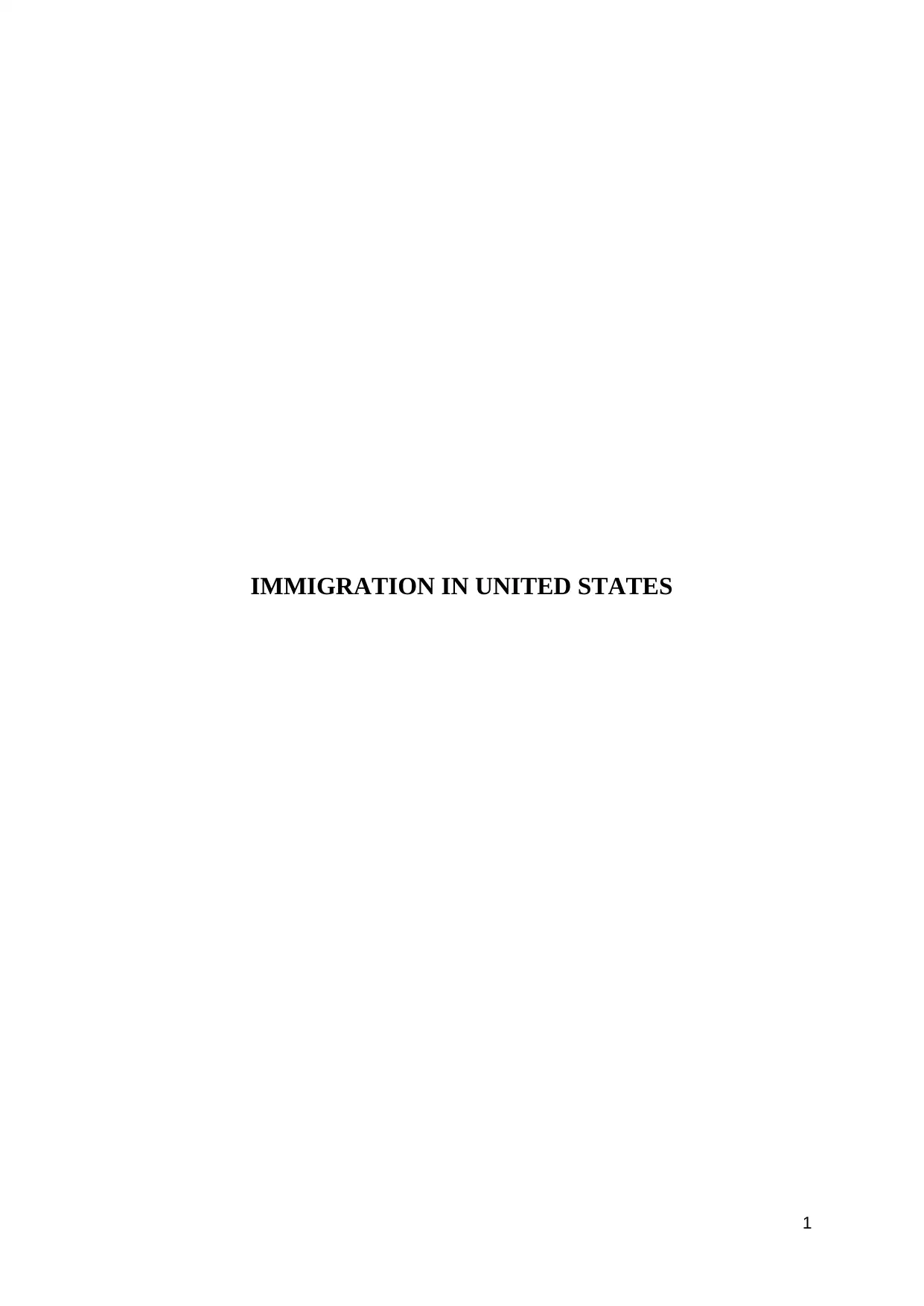
IMMIGRATION IN UNITED STATES
1
1
Secure Best Marks with AI Grader
Need help grading? Try our AI Grader for instant feedback on your assignments.
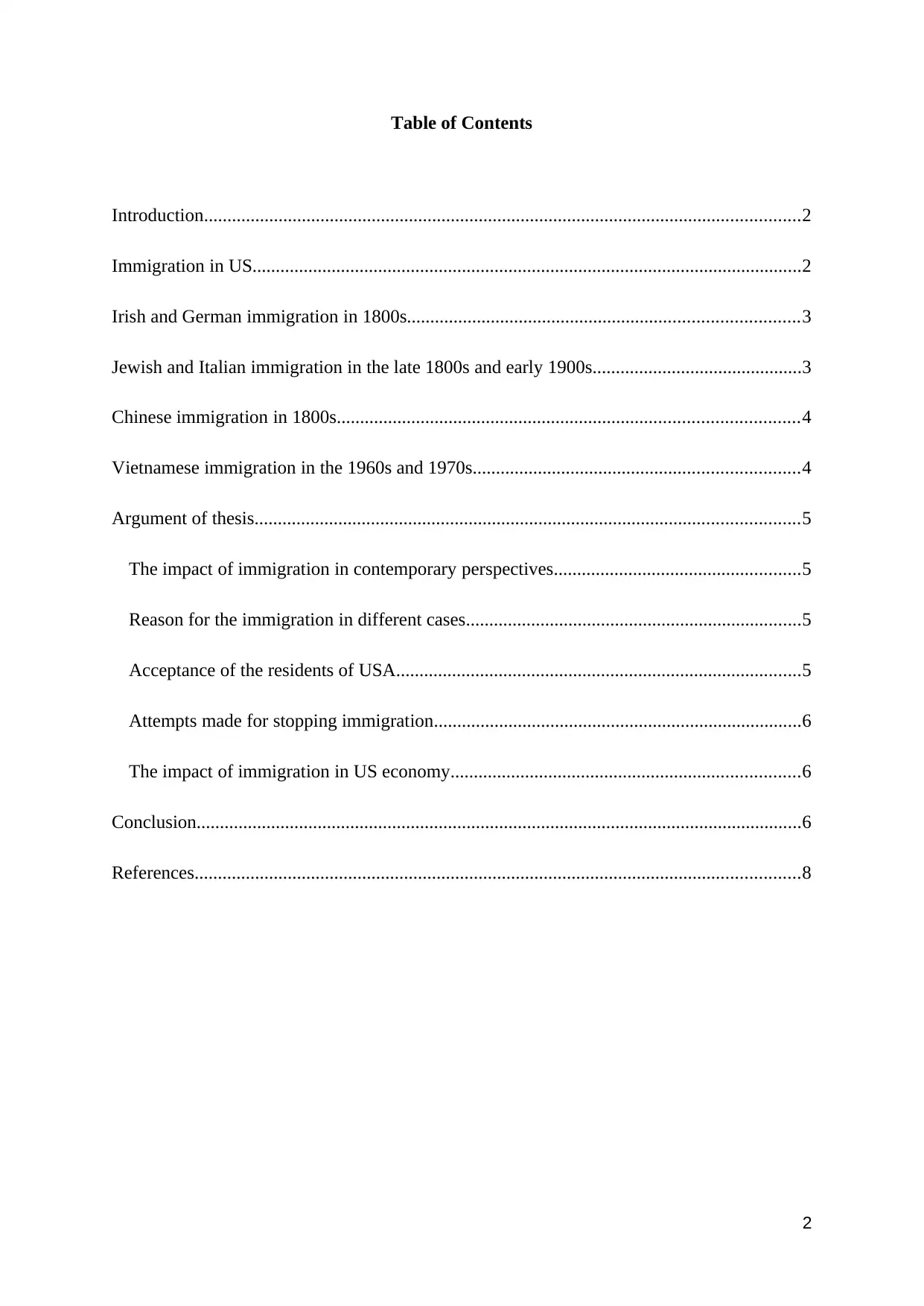
Table of Contents
Introduction................................................................................................................................2
Immigration in US......................................................................................................................2
Irish and German immigration in 1800s....................................................................................3
Jewish and Italian immigration in the late 1800s and early 1900s.............................................3
Chinese immigration in 1800s...................................................................................................4
Vietnamese immigration in the 1960s and 1970s......................................................................4
Argument of thesis.....................................................................................................................5
The impact of immigration in contemporary perspectives.....................................................5
Reason for the immigration in different cases........................................................................5
Acceptance of the residents of USA.......................................................................................5
Attempts made for stopping immigration...............................................................................6
The impact of immigration in US economy...........................................................................6
Conclusion..................................................................................................................................6
References..................................................................................................................................8
2
Introduction................................................................................................................................2
Immigration in US......................................................................................................................2
Irish and German immigration in 1800s....................................................................................3
Jewish and Italian immigration in the late 1800s and early 1900s.............................................3
Chinese immigration in 1800s...................................................................................................4
Vietnamese immigration in the 1960s and 1970s......................................................................4
Argument of thesis.....................................................................................................................5
The impact of immigration in contemporary perspectives.....................................................5
Reason for the immigration in different cases........................................................................5
Acceptance of the residents of USA.......................................................................................5
Attempts made for stopping immigration...............................................................................6
The impact of immigration in US economy...........................................................................6
Conclusion..................................................................................................................................6
References..................................................................................................................................8
2
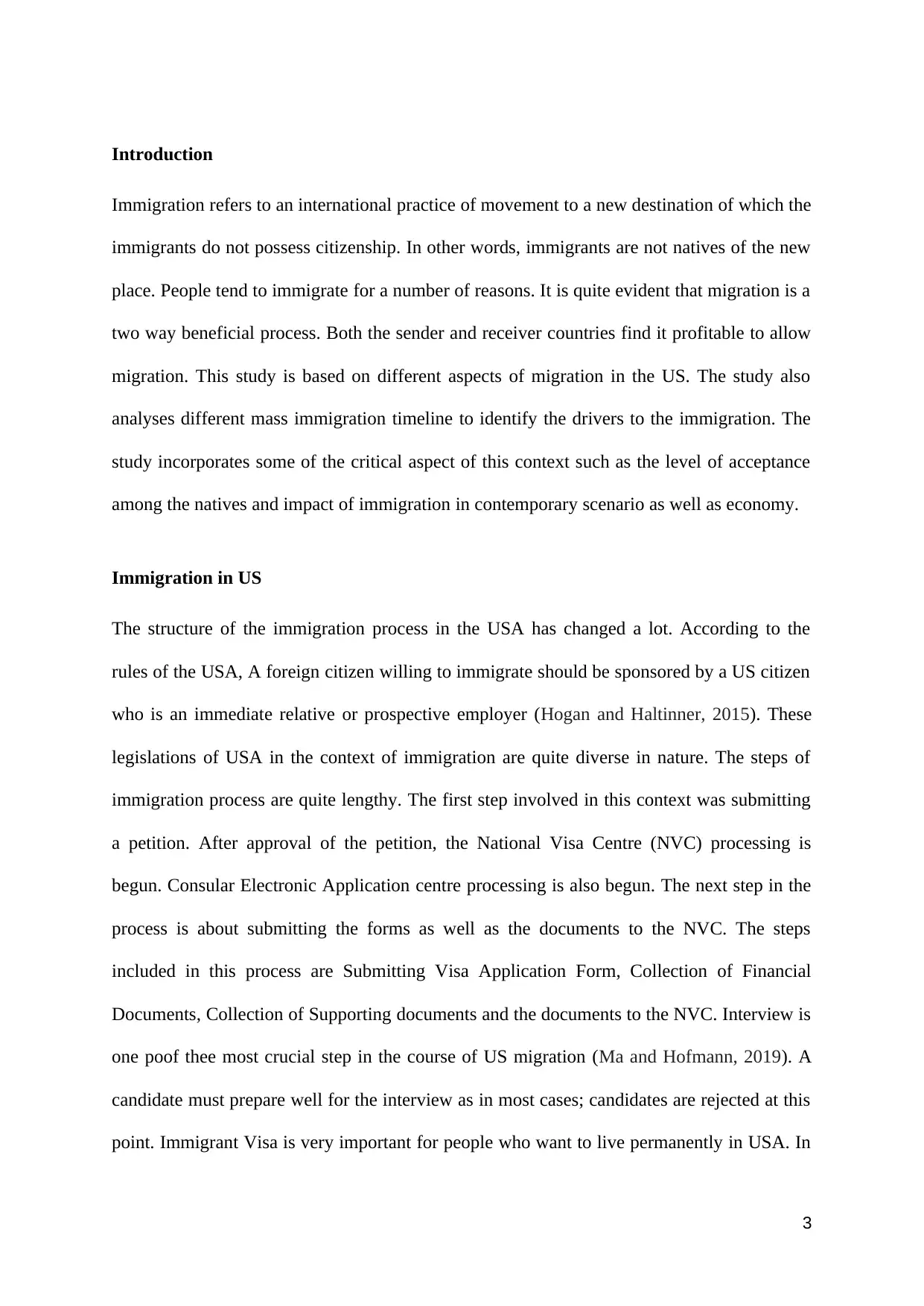
Introduction
Immigration refers to an international practice of movement to a new destination of which the
immigrants do not possess citizenship. In other words, immigrants are not natives of the new
place. People tend to immigrate for a number of reasons. It is quite evident that migration is a
two way beneficial process. Both the sender and receiver countries find it profitable to allow
migration. This study is based on different aspects of migration in the US. The study also
analyses different mass immigration timeline to identify the drivers to the immigration. The
study incorporates some of the critical aspect of this context such as the level of acceptance
among the natives and impact of immigration in contemporary scenario as well as economy.
Immigration in US
The structure of the immigration process in the USA has changed a lot. According to the
rules of the USA, A foreign citizen willing to immigrate should be sponsored by a US citizen
who is an immediate relative or prospective employer (Hogan and Haltinner, 2015). These
legislations of USA in the context of immigration are quite diverse in nature. The steps of
immigration process are quite lengthy. The first step involved in this context was submitting
a petition. After approval of the petition, the National Visa Centre (NVC) processing is
begun. Consular Electronic Application centre processing is also begun. The next step in the
process is about submitting the forms as well as the documents to the NVC. The steps
included in this process are Submitting Visa Application Form, Collection of Financial
Documents, Collection of Supporting documents and the documents to the NVC. Interview is
one poof thee most crucial step in the course of US migration (Ma and Hofmann, 2019). A
candidate must prepare well for the interview as in most cases; candidates are rejected at this
point. Immigrant Visa is very important for people who want to live permanently in USA. In
3
Immigration refers to an international practice of movement to a new destination of which the
immigrants do not possess citizenship. In other words, immigrants are not natives of the new
place. People tend to immigrate for a number of reasons. It is quite evident that migration is a
two way beneficial process. Both the sender and receiver countries find it profitable to allow
migration. This study is based on different aspects of migration in the US. The study also
analyses different mass immigration timeline to identify the drivers to the immigration. The
study incorporates some of the critical aspect of this context such as the level of acceptance
among the natives and impact of immigration in contemporary scenario as well as economy.
Immigration in US
The structure of the immigration process in the USA has changed a lot. According to the
rules of the USA, A foreign citizen willing to immigrate should be sponsored by a US citizen
who is an immediate relative or prospective employer (Hogan and Haltinner, 2015). These
legislations of USA in the context of immigration are quite diverse in nature. The steps of
immigration process are quite lengthy. The first step involved in this context was submitting
a petition. After approval of the petition, the National Visa Centre (NVC) processing is
begun. Consular Electronic Application centre processing is also begun. The next step in the
process is about submitting the forms as well as the documents to the NVC. The steps
included in this process are Submitting Visa Application Form, Collection of Financial
Documents, Collection of Supporting documents and the documents to the NVC. Interview is
one poof thee most crucial step in the course of US migration (Ma and Hofmann, 2019). A
candidate must prepare well for the interview as in most cases; candidates are rejected at this
point. Immigrant Visa is very important for people who want to live permanently in USA. In
3
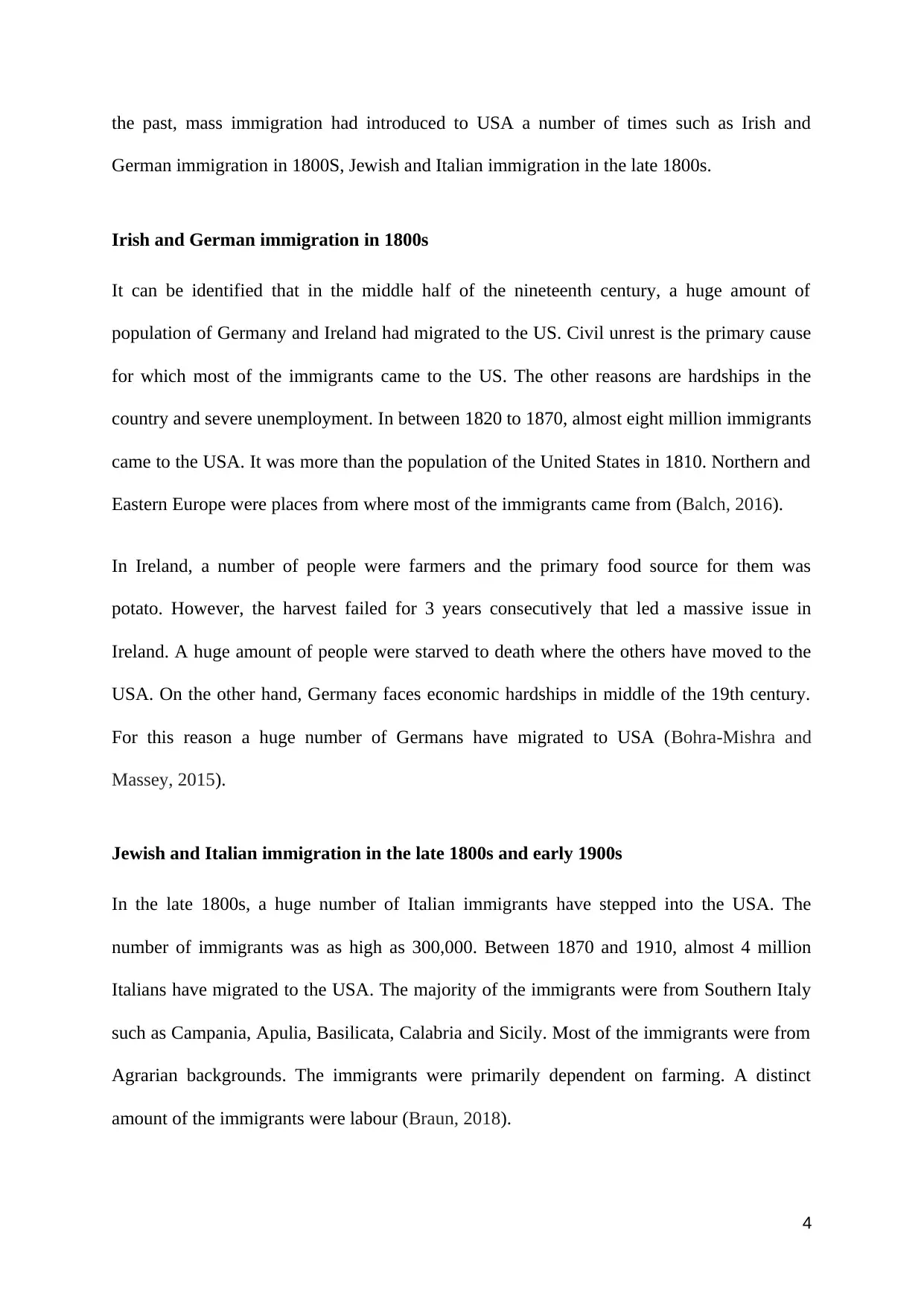
the past, mass immigration had introduced to USA a number of times such as Irish and
German immigration in 1800S, Jewish and Italian immigration in the late 1800s.
Irish and German immigration in 1800s
It can be identified that in the middle half of the nineteenth century, a huge amount of
population of Germany and Ireland had migrated to the US. Civil unrest is the primary cause
for which most of the immigrants came to the US. The other reasons are hardships in the
country and severe unemployment. In between 1820 to 1870, almost eight million immigrants
came to the USA. It was more than the population of the United States in 1810. Northern and
Eastern Europe were places from where most of the immigrants came from (Balch, 2016).
In Ireland, a number of people were farmers and the primary food source for them was
potato. However, the harvest failed for 3 years consecutively that led a massive issue in
Ireland. A huge amount of people were starved to death where the others have moved to the
USA. On the other hand, Germany faces economic hardships in middle of the 19th century.
For this reason a huge number of Germans have migrated to USA (Bohra-Mishra and
Massey, 2015).
Jewish and Italian immigration in the late 1800s and early 1900s
In the late 1800s, a huge number of Italian immigrants have stepped into the USA. The
number of immigrants was as high as 300,000. Between 1870 and 1910, almost 4 million
Italians have migrated to the USA. The majority of the immigrants were from Southern Italy
such as Campania, Apulia, Basilicata, Calabria and Sicily. Most of the immigrants were from
Agrarian backgrounds. The immigrants were primarily dependent on farming. A distinct
amount of the immigrants were labour (Braun, 2018).
4
German immigration in 1800S, Jewish and Italian immigration in the late 1800s.
Irish and German immigration in 1800s
It can be identified that in the middle half of the nineteenth century, a huge amount of
population of Germany and Ireland had migrated to the US. Civil unrest is the primary cause
for which most of the immigrants came to the US. The other reasons are hardships in the
country and severe unemployment. In between 1820 to 1870, almost eight million immigrants
came to the USA. It was more than the population of the United States in 1810. Northern and
Eastern Europe were places from where most of the immigrants came from (Balch, 2016).
In Ireland, a number of people were farmers and the primary food source for them was
potato. However, the harvest failed for 3 years consecutively that led a massive issue in
Ireland. A huge amount of people were starved to death where the others have moved to the
USA. On the other hand, Germany faces economic hardships in middle of the 19th century.
For this reason a huge number of Germans have migrated to USA (Bohra-Mishra and
Massey, 2015).
Jewish and Italian immigration in the late 1800s and early 1900s
In the late 1800s, a huge number of Italian immigrants have stepped into the USA. The
number of immigrants was as high as 300,000. Between 1870 and 1910, almost 4 million
Italians have migrated to the USA. The majority of the immigrants were from Southern Italy
such as Campania, Apulia, Basilicata, Calabria and Sicily. Most of the immigrants were from
Agrarian backgrounds. The immigrants were primarily dependent on farming. A distinct
amount of the immigrants were labour (Braun, 2018).
4
Secure Best Marks with AI Grader
Need help grading? Try our AI Grader for instant feedback on your assignments.
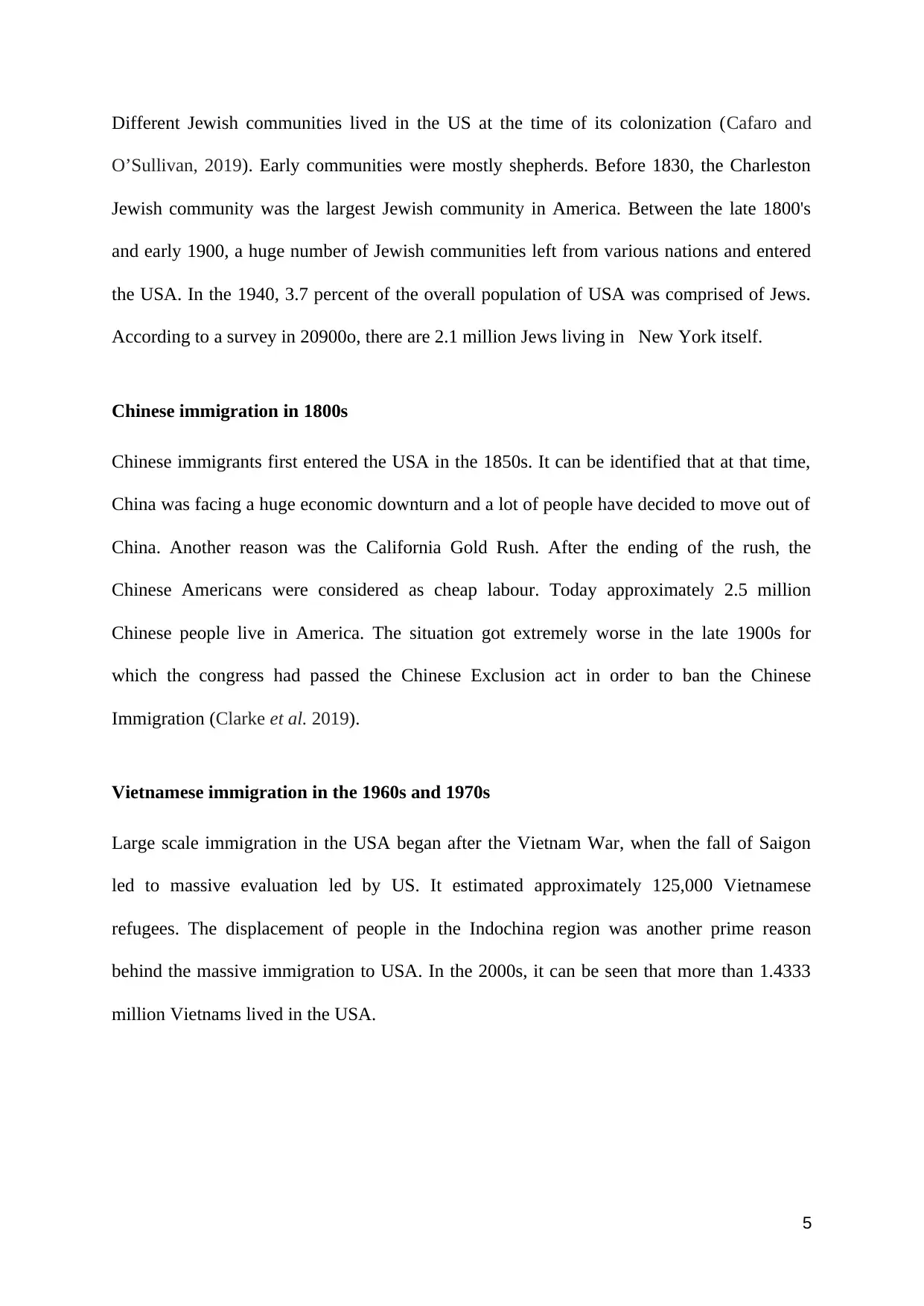
Different Jewish communities lived in the US at the time of its colonization (Cafaro and
O’Sullivan, 2019). Early communities were mostly shepherds. Before 1830, the Charleston
Jewish community was the largest Jewish community in America. Between the late 1800's
and early 1900, a huge number of Jewish communities left from various nations and entered
the USA. In the 1940, 3.7 percent of the overall population of USA was comprised of Jews.
According to a survey in 20900o, there are 2.1 million Jews living in New York itself.
Chinese immigration in 1800s
Chinese immigrants first entered the USA in the 1850s. It can be identified that at that time,
China was facing a huge economic downturn and a lot of people have decided to move out of
China. Another reason was the California Gold Rush. After the ending of the rush, the
Chinese Americans were considered as cheap labour. Today approximately 2.5 million
Chinese people live in America. The situation got extremely worse in the late 1900s for
which the congress had passed the Chinese Exclusion act in order to ban the Chinese
Immigration (Clarke et al. 2019).
Vietnamese immigration in the 1960s and 1970s
Large scale immigration in the USA began after the Vietnam War, when the fall of Saigon
led to massive evaluation led by US. It estimated approximately 125,000 Vietnamese
refugees. The displacement of people in the Indochina region was another prime reason
behind the massive immigration to USA. In the 2000s, it can be seen that more than 1.4333
million Vietnams lived in the USA.
5
O’Sullivan, 2019). Early communities were mostly shepherds. Before 1830, the Charleston
Jewish community was the largest Jewish community in America. Between the late 1800's
and early 1900, a huge number of Jewish communities left from various nations and entered
the USA. In the 1940, 3.7 percent of the overall population of USA was comprised of Jews.
According to a survey in 20900o, there are 2.1 million Jews living in New York itself.
Chinese immigration in 1800s
Chinese immigrants first entered the USA in the 1850s. It can be identified that at that time,
China was facing a huge economic downturn and a lot of people have decided to move out of
China. Another reason was the California Gold Rush. After the ending of the rush, the
Chinese Americans were considered as cheap labour. Today approximately 2.5 million
Chinese people live in America. The situation got extremely worse in the late 1900s for
which the congress had passed the Chinese Exclusion act in order to ban the Chinese
Immigration (Clarke et al. 2019).
Vietnamese immigration in the 1960s and 1970s
Large scale immigration in the USA began after the Vietnam War, when the fall of Saigon
led to massive evaluation led by US. It estimated approximately 125,000 Vietnamese
refugees. The displacement of people in the Indochina region was another prime reason
behind the massive immigration to USA. In the 2000s, it can be seen that more than 1.4333
million Vietnams lived in the USA.
5
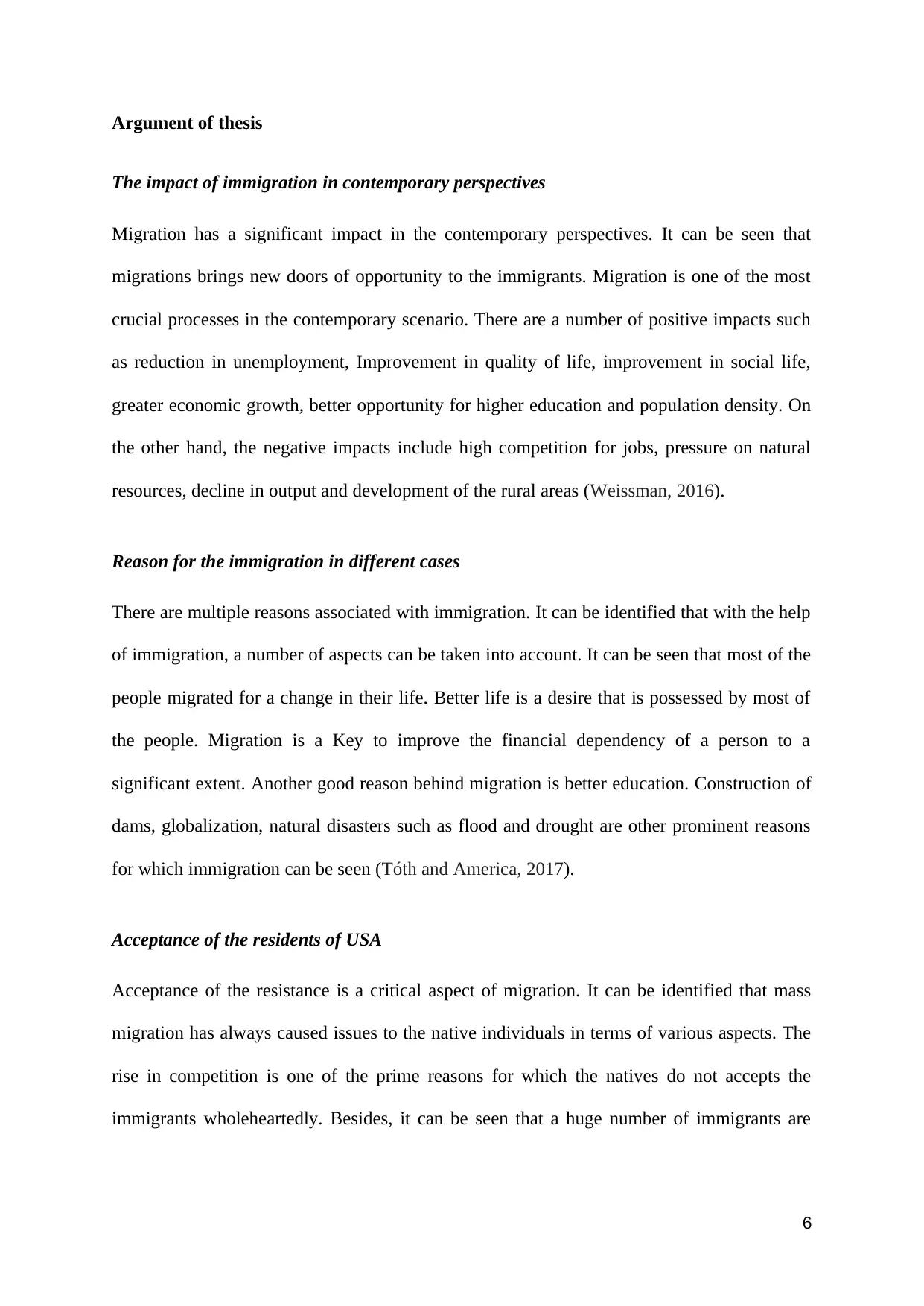
Argument of thesis
The impact of immigration in contemporary perspectives
Migration has a significant impact in the contemporary perspectives. It can be seen that
migrations brings new doors of opportunity to the immigrants. Migration is one of the most
crucial processes in the contemporary scenario. There are a number of positive impacts such
as reduction in unemployment, Improvement in quality of life, improvement in social life,
greater economic growth, better opportunity for higher education and population density. On
the other hand, the negative impacts include high competition for jobs, pressure on natural
resources, decline in output and development of the rural areas (Weissman, 2016).
Reason for the immigration in different cases
There are multiple reasons associated with immigration. It can be identified that with the help
of immigration, a number of aspects can be taken into account. It can be seen that most of the
people migrated for a change in their life. Better life is a desire that is possessed by most of
the people. Migration is a Key to improve the financial dependency of a person to a
significant extent. Another good reason behind migration is better education. Construction of
dams, globalization, natural disasters such as flood and drought are other prominent reasons
for which immigration can be seen (Tóth and America, 2017).
Acceptance of the residents of USA
Acceptance of the resistance is a critical aspect of migration. It can be identified that mass
migration has always caused issues to the native individuals in terms of various aspects. The
rise in competition is one of the prime reasons for which the natives do not accepts the
immigrants wholeheartedly. Besides, it can be seen that a huge number of immigrants are
6
The impact of immigration in contemporary perspectives
Migration has a significant impact in the contemporary perspectives. It can be seen that
migrations brings new doors of opportunity to the immigrants. Migration is one of the most
crucial processes in the contemporary scenario. There are a number of positive impacts such
as reduction in unemployment, Improvement in quality of life, improvement in social life,
greater economic growth, better opportunity for higher education and population density. On
the other hand, the negative impacts include high competition for jobs, pressure on natural
resources, decline in output and development of the rural areas (Weissman, 2016).
Reason for the immigration in different cases
There are multiple reasons associated with immigration. It can be identified that with the help
of immigration, a number of aspects can be taken into account. It can be seen that most of the
people migrated for a change in their life. Better life is a desire that is possessed by most of
the people. Migration is a Key to improve the financial dependency of a person to a
significant extent. Another good reason behind migration is better education. Construction of
dams, globalization, natural disasters such as flood and drought are other prominent reasons
for which immigration can be seen (Tóth and America, 2017).
Acceptance of the residents of USA
Acceptance of the resistance is a critical aspect of migration. It can be identified that mass
migration has always caused issues to the native individuals in terms of various aspects. The
rise in competition is one of the prime reasons for which the natives do not accepts the
immigrants wholeheartedly. Besides, it can be seen that a huge number of immigrants are
6
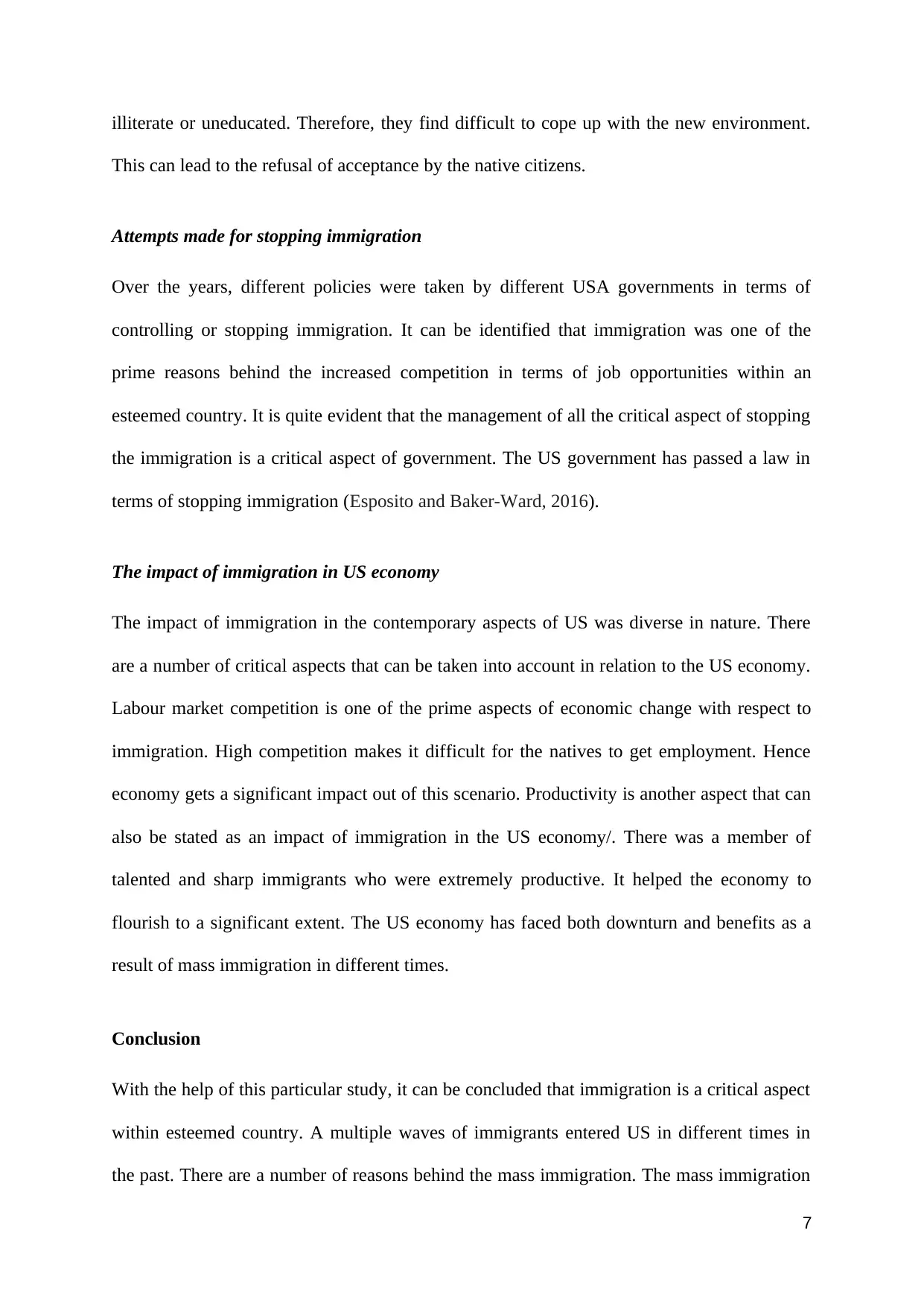
illiterate or uneducated. Therefore, they find difficult to cope up with the new environment.
This can lead to the refusal of acceptance by the native citizens.
Attempts made for stopping immigration
Over the years, different policies were taken by different USA governments in terms of
controlling or stopping immigration. It can be identified that immigration was one of the
prime reasons behind the increased competition in terms of job opportunities within an
esteemed country. It is quite evident that the management of all the critical aspect of stopping
the immigration is a critical aspect of government. The US government has passed a law in
terms of stopping immigration (Esposito and Baker-Ward, 2016).
The impact of immigration in US economy
The impact of immigration in the contemporary aspects of US was diverse in nature. There
are a number of critical aspects that can be taken into account in relation to the US economy.
Labour market competition is one of the prime aspects of economic change with respect to
immigration. High competition makes it difficult for the natives to get employment. Hence
economy gets a significant impact out of this scenario. Productivity is another aspect that can
also be stated as an impact of immigration in the US economy/. There was a member of
talented and sharp immigrants who were extremely productive. It helped the economy to
flourish to a significant extent. The US economy has faced both downturn and benefits as a
result of mass immigration in different times.
Conclusion
With the help of this particular study, it can be concluded that immigration is a critical aspect
within esteemed country. A multiple waves of immigrants entered US in different times in
the past. There are a number of reasons behind the mass immigration. The mass immigration
7
This can lead to the refusal of acceptance by the native citizens.
Attempts made for stopping immigration
Over the years, different policies were taken by different USA governments in terms of
controlling or stopping immigration. It can be identified that immigration was one of the
prime reasons behind the increased competition in terms of job opportunities within an
esteemed country. It is quite evident that the management of all the critical aspect of stopping
the immigration is a critical aspect of government. The US government has passed a law in
terms of stopping immigration (Esposito and Baker-Ward, 2016).
The impact of immigration in US economy
The impact of immigration in the contemporary aspects of US was diverse in nature. There
are a number of critical aspects that can be taken into account in relation to the US economy.
Labour market competition is one of the prime aspects of economic change with respect to
immigration. High competition makes it difficult for the natives to get employment. Hence
economy gets a significant impact out of this scenario. Productivity is another aspect that can
also be stated as an impact of immigration in the US economy/. There was a member of
talented and sharp immigrants who were extremely productive. It helped the economy to
flourish to a significant extent. The US economy has faced both downturn and benefits as a
result of mass immigration in different times.
Conclusion
With the help of this particular study, it can be concluded that immigration is a critical aspect
within esteemed country. A multiple waves of immigrants entered US in different times in
the past. There are a number of reasons behind the mass immigration. The mass immigration
7
Paraphrase This Document
Need a fresh take? Get an instant paraphrase of this document with our AI Paraphraser
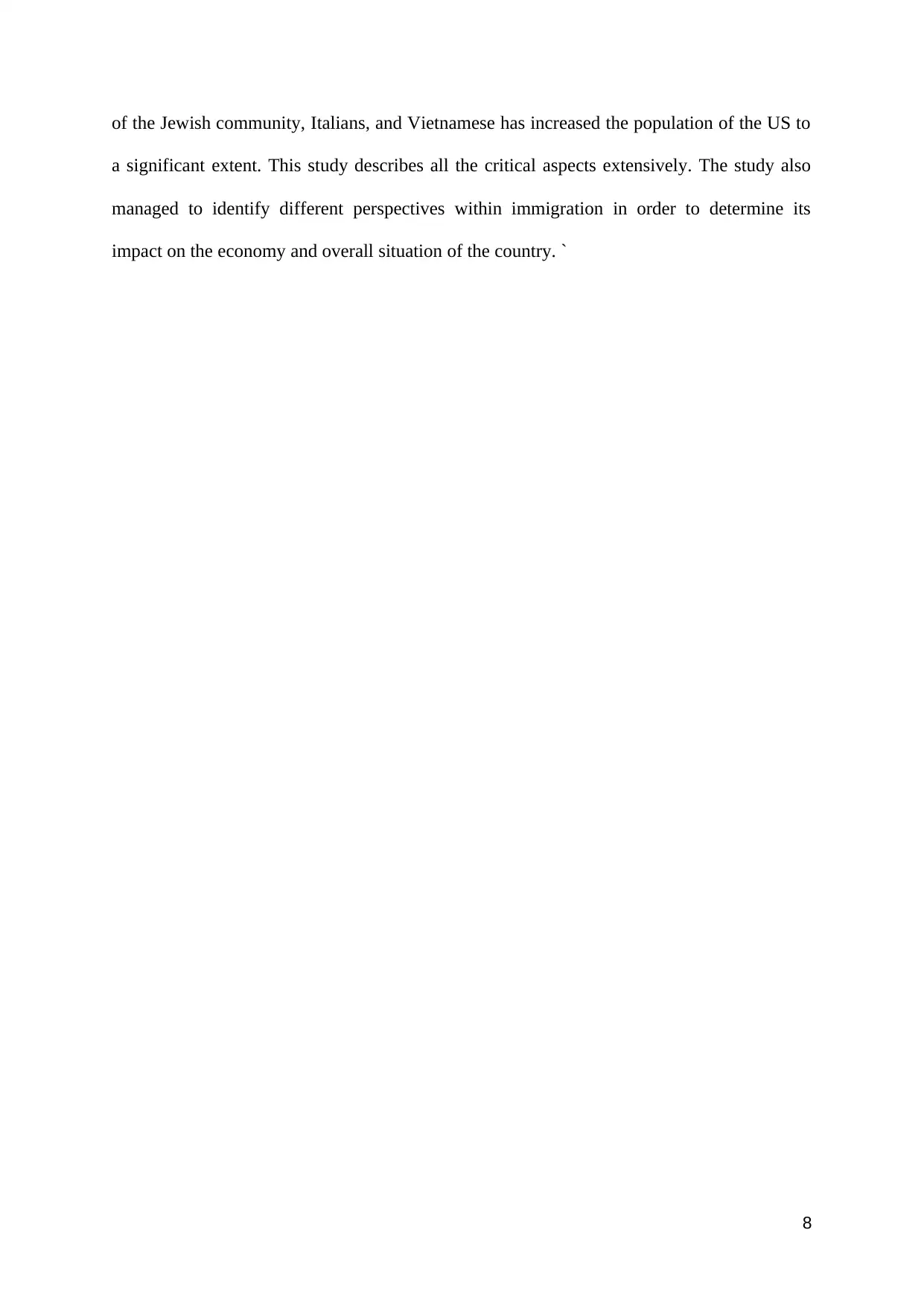
of the Jewish community, Italians, and Vietnamese has increased the population of the US to
a significant extent. This study describes all the critical aspects extensively. The study also
managed to identify different perspectives within immigration in order to determine its
impact on the economy and overall situation of the country. `
8
a significant extent. This study describes all the critical aspects extensively. The study also
managed to identify different perspectives within immigration in order to determine its
impact on the economy and overall situation of the country. `
8
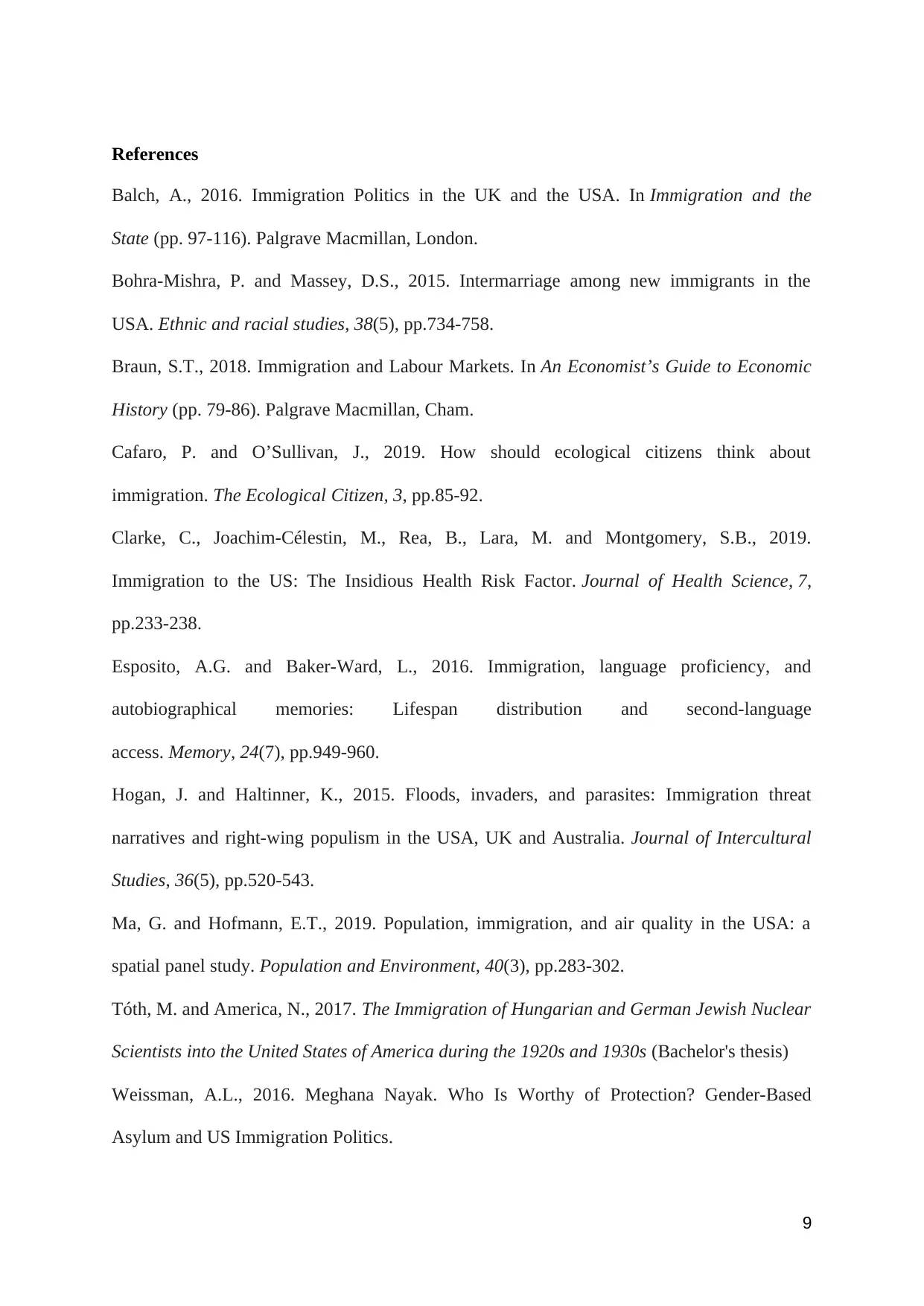
References
Balch, A., 2016. Immigration Politics in the UK and the USA. In Immigration and the
State (pp. 97-116). Palgrave Macmillan, London.
Bohra-Mishra, P. and Massey, D.S., 2015. Intermarriage among new immigrants in the
USA. Ethnic and racial studies, 38(5), pp.734-758.
Braun, S.T., 2018. Immigration and Labour Markets. In An Economist’s Guide to Economic
History (pp. 79-86). Palgrave Macmillan, Cham.
Cafaro, P. and O’Sullivan, J., 2019. How should ecological citizens think about
immigration. The Ecological Citizen, 3, pp.85-92.
Clarke, C., Joachim-Célestin, M., Rea, B., Lara, M. and Montgomery, S.B., 2019.
Immigration to the US: The Insidious Health Risk Factor. Journal of Health Science, 7,
pp.233-238.
Esposito, A.G. and Baker-Ward, L., 2016. Immigration, language proficiency, and
autobiographical memories: Lifespan distribution and second-language
access. Memory, 24(7), pp.949-960.
Hogan, J. and Haltinner, K., 2015. Floods, invaders, and parasites: Immigration threat
narratives and right-wing populism in the USA, UK and Australia. Journal of Intercultural
Studies, 36(5), pp.520-543.
Ma, G. and Hofmann, E.T., 2019. Population, immigration, and air quality in the USA: a
spatial panel study. Population and Environment, 40(3), pp.283-302.
Tóth, M. and America, N., 2017. The Immigration of Hungarian and German Jewish Nuclear
Scientists into the United States of America during the 1920s and 1930s (Bachelor's thesis)
Weissman, A.L., 2016. Meghana Nayak. Who Is Worthy of Protection? Gender-Based
Asylum and US Immigration Politics.
9
Balch, A., 2016. Immigration Politics in the UK and the USA. In Immigration and the
State (pp. 97-116). Palgrave Macmillan, London.
Bohra-Mishra, P. and Massey, D.S., 2015. Intermarriage among new immigrants in the
USA. Ethnic and racial studies, 38(5), pp.734-758.
Braun, S.T., 2018. Immigration and Labour Markets. In An Economist’s Guide to Economic
History (pp. 79-86). Palgrave Macmillan, Cham.
Cafaro, P. and O’Sullivan, J., 2019. How should ecological citizens think about
immigration. The Ecological Citizen, 3, pp.85-92.
Clarke, C., Joachim-Célestin, M., Rea, B., Lara, M. and Montgomery, S.B., 2019.
Immigration to the US: The Insidious Health Risk Factor. Journal of Health Science, 7,
pp.233-238.
Esposito, A.G. and Baker-Ward, L., 2016. Immigration, language proficiency, and
autobiographical memories: Lifespan distribution and second-language
access. Memory, 24(7), pp.949-960.
Hogan, J. and Haltinner, K., 2015. Floods, invaders, and parasites: Immigration threat
narratives and right-wing populism in the USA, UK and Australia. Journal of Intercultural
Studies, 36(5), pp.520-543.
Ma, G. and Hofmann, E.T., 2019. Population, immigration, and air quality in the USA: a
spatial panel study. Population and Environment, 40(3), pp.283-302.
Tóth, M. and America, N., 2017. The Immigration of Hungarian and German Jewish Nuclear
Scientists into the United States of America during the 1920s and 1930s (Bachelor's thesis)
Weissman, A.L., 2016. Meghana Nayak. Who Is Worthy of Protection? Gender-Based
Asylum and US Immigration Politics.
9
1 out of 9
Your All-in-One AI-Powered Toolkit for Academic Success.
+13062052269
info@desklib.com
Available 24*7 on WhatsApp / Email
![[object Object]](/_next/static/media/star-bottom.7253800d.svg)
Unlock your academic potential
© 2024 | Zucol Services PVT LTD | All rights reserved.